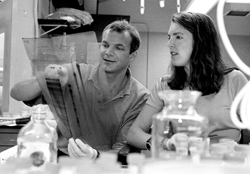By Sally Pobojewski
News and Information Services

Scientists at the Medical School have discovered a molecular switch that controls the formation of fat cells in mice. If the switch is on, fat cells will not develop. Switch it off, and even would-be muscle cells turn to fat.
This powerful molecular switch is one of several related proteins called Wnts (pronounced “wints”), which exist in all types of animals. Wnts regulate the complex genetic and biochemical changes that take place during embryological development.
Development begins with a ball of generic stem cells capable of becoming any type of cell. Stem cells become precursor cells, which can change into a limited number of cell types. By the end of the developmental stage, cells are committed to just one cellular future.
Scientists knew that Wnt proteins were involved in early cell development, but the U-M study is the first to identify the importance of Wnts in fat cell formation. “We found that Wnt signaling represses adipogenesis or fat cell development,” says Sarah E. Ross, a graduate student and first author of the study published in the Aug. 11 issue of Science.
“This is just the first piece of the puzzle, but it is an important one,” says Ormond A. MacDougald, who directed the study. MacDougald is an assistant professor of physiology in the Medical School and a member of the Center for Organogenesis. “Understanding this developmental pathway could help scientists learn how and why obesity develops.”
MacDougald and his research team worked with two types of mouse cells—precursor muscle cells called myoblasts and precursor fat cells called preadipocytes. “In the absence of Wnt, both cell types consistently differentiated into fat cells,” Ross says.
When Wnt protein binds to a cell membrane receptor, it sets off a chain of biochemical signals, according to Ross. Signals are passed from one messenger molecule to another until they reach the cell nucleus where they either turn on or turn off genes that regulate development.
Ross demonstrated Wnt’s power to control cell differentiation by blocking proteins in this signaling pathway to interrupt the Wnt signal. After just a few days, myoblasts already on their way to differentiating into muscle cells spontaneously switched gears and became fat cells instead.
Other significant results documented in the Science article include:
In future research, MacDougald will study whether Wnt 10b has the same fat cell-inhibiting effect in living mice as it does in mouse cell cultures. “We plan to use genetic engineering to direct expression of Wnt 10b to the developing adipocyte,” says MacDougald. “Our goal is to create a fat-free mouse.”
Other U-M collaborators in the study included Nahid Hemati, research associate; Kenneth A. Longo, postdoctoral fellow; Christina Bennett and Robin Erickson, graduate students; and Peter C. Lucas, resident in pathology. The study was funded by the National Institutes of Health, the Natural Sciences and Engineering Research Council of Canada, and the U-M.

